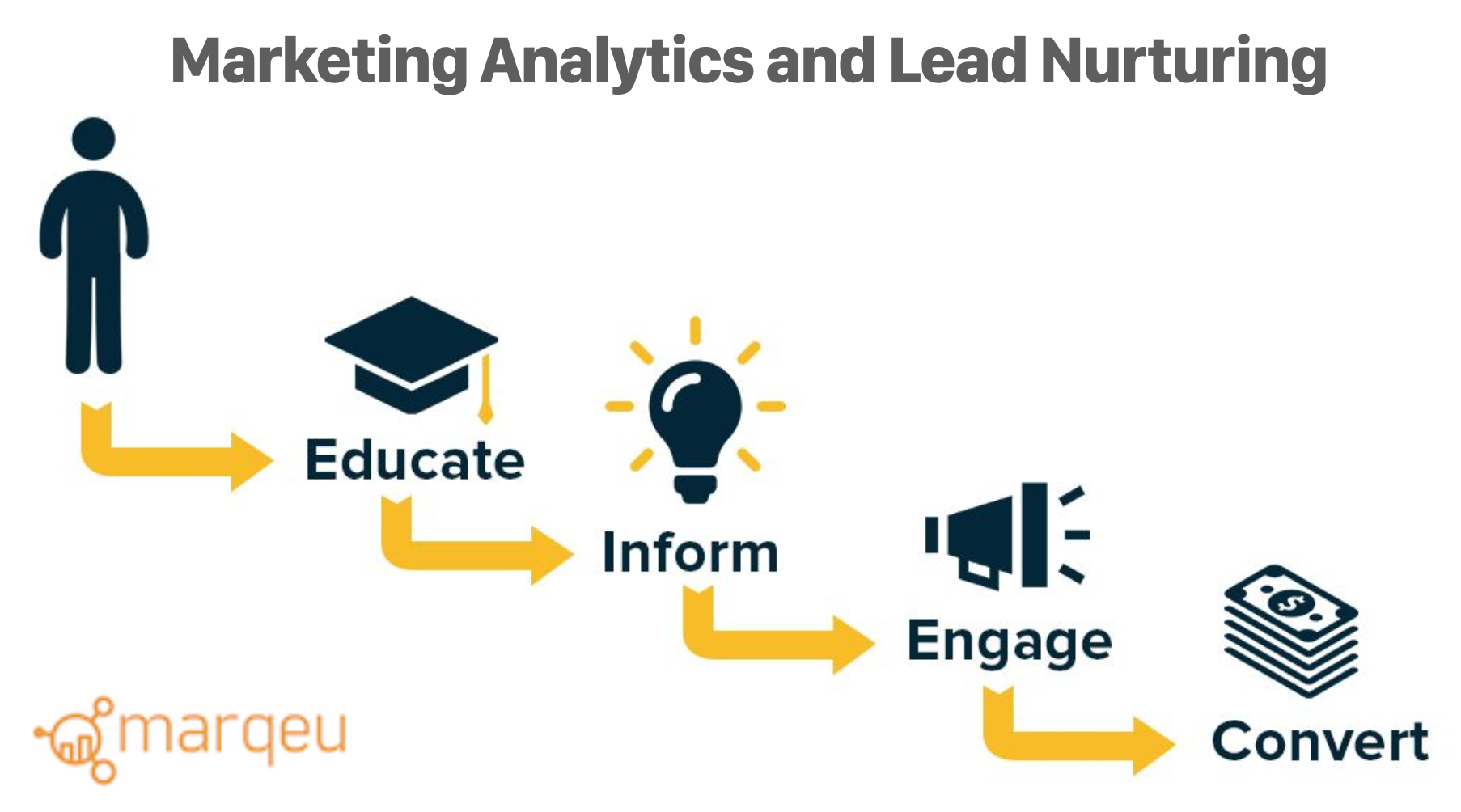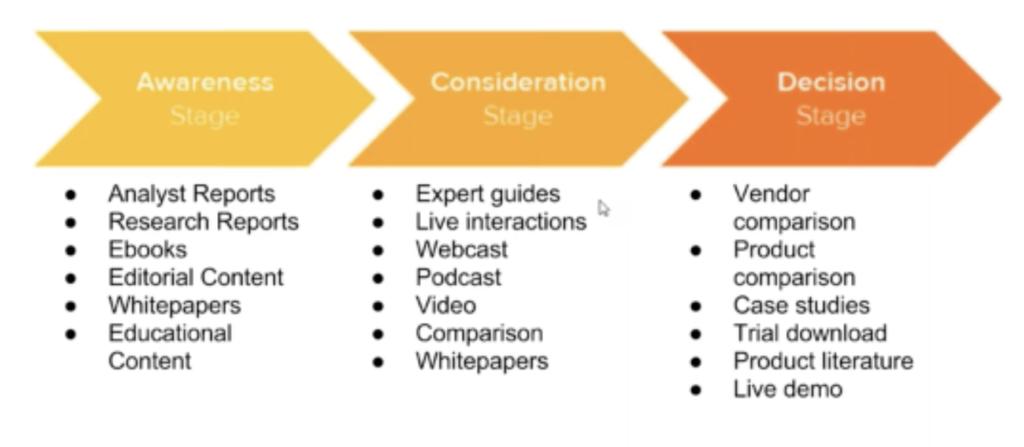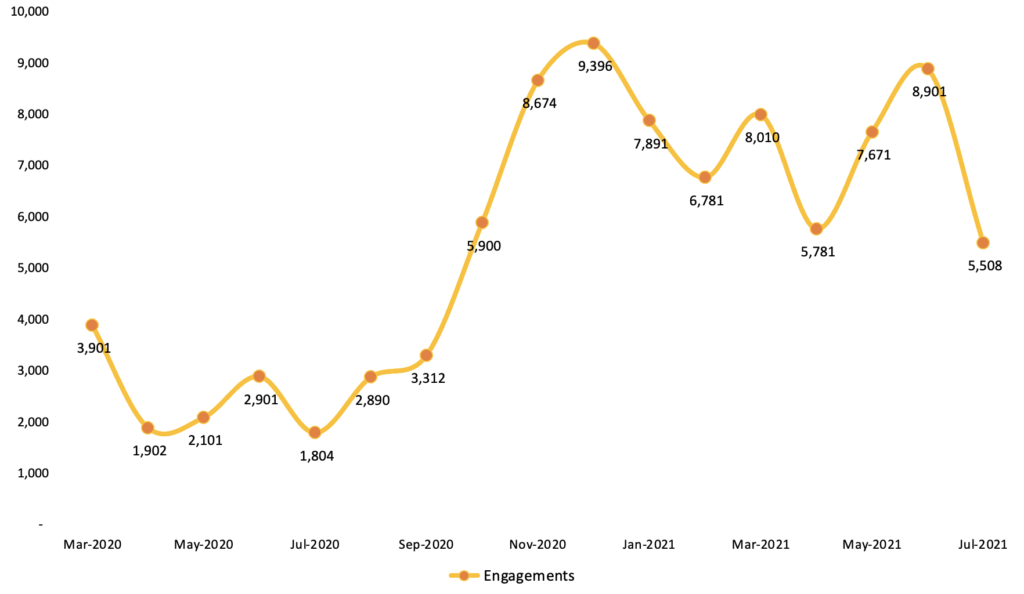
Marketing Analytics and Lead Nurturing – A Strategic Combination
Marketing Analytics and Lead Nurturing is a strategic combination across all revenue marketing organizations. A well-thought-out lead nurture strategy backed by data-driven insights through marketing analytics frameworks is a game-changer. While others see nurturing as a series of emails, we see nurturing differently.
For us, nurturing is a data-driven, meticulously planned contextual, and hyper-personalized strategic marketing tactic to drive engagement in pursuit of influencing pipeline generation.
Lead Nurturing is an ongoing process, which prepares the engaged leads for sales conversations based on their engagements with the different phases of the nurture campaigns. For the marketing teams, it is critical to have an engaging and relevant nurture strategy customized for different persona who are in different phases of the buying cycle from awareness, consideration, preference to purchase. Nurtures themselves could have different goals ranging from spreading awareness about the product/services through thought leadership, driving engagement with the potential customers about the brand of an organization to accelerating the leads through the funnel.
Given that email messaging and contextual CTAs are the core part of the nurture campaigns, traditionally most marketing organizations have been focused on looking at vanity email metrics (email opens, email clicks, etc.) to track the results of nurture campaigns. As most revenue-focused marketing leaders would agree, these metrics do not cut it anymore when it comes to demonstrating the impact of nurture campaigns on the pipeline. This is where
our nurture performance analytics frameworks, data models, and dashboards have been extremely helpful at not only showing the impact of the nurture campaigns on the pipeline but at providing valuable insights to the marketing teams when it comes to optimizing the nurture content, offers, cadences, and targeting.
As part of our engagement and nurture analytics services, we work with the marketing organization to understand the sales and marketing operating model and the buyer’s journey. We then build and implement nurture analytics data models to provide visibility into understanding the performance of all nurture campaigns across 2 broad areas:
- The ability to drive engagement with the contacts added to the nurture campaigns. Opening and clicking a nurture email is a positive indicator of the relevancy and targeting of the nurture campaigns. Our approach has been to go beyond these metrics and further narrow down the criteria when it comes to tracking the true impact of the nurture campaigns on driving engagement with the contacts who influence pipeline generation. While the definition of the “engaged” contacts can vary across different companies but broadly it covers these data points:
- The number of email engagements in a given time frame (usually past 90 days). Analyzing the frequency and recency of the engagements together is a strong indicator of qualification.
- The number of responses to the CTAs in the nurture emails – the higher the number, the better it is.
- The funnel status/stage of the engaged contacts.
- The recency of sales conversation and sales activities.
- The ability of the nurture campaigns to influence pipeline generation. The importance of demonstrating how marketing activities are impacting the pipeline has grown manifolds in recent times. With the pipeline attribution frameworks, marketing teams can quantify the engagements driven by the nurture campaigns across the accounts and relate them to the pipeline generation. These pipeline correlations of the marketing activities (including nurture campaigns) provide valuable insights when it comes to understanding “when” the new opportunities were created in the marketing engaged accounts and for the accounts with existing opportunities, how marketing campaigns were able to influence deal expansion and accelerate deal closures. Pipeline influence data models also provide details into the metadata for nurture campaigns. These granular data points enable detailed comparison analysis among different nurture campaigns to better understand which nurtures are driving engagements across the accounts from different demographics. These insights further help with aligning the content and the CTAs of the nurture campaigns to drive higher engagement.

The set of these pipeline-focused KPIs provides insights to the growth marketing leaders so that they can objectively evaluate the performance of different nurture campaigns, leverage actionable data to continuously optimize the performance, and above all, confidently demonstrate the impact that their campaigns are making on the pipeline. As is demonstrated by this graph (with data till mid-July’21),
we leveraged our nurture marketing analytics frameworks to drive increased engagement and hence pipeline influence for one of our customers,
which like most of the B2B marketing organizations have lead nurturing as the core part of their marketing mix.

We are always on the lookout for inputs and examples from the marketing community to keep providing unparalleled value for our customers. We welcome the inputs from other marketing, revenue operations leaders, and practitioners around what metrics they are using to demonstrate the impact of nurture campaigns? What challenges do they face when it comes to accessing the data for nurture campaigns and how are they co-relating the nurture engagements with pipeline influence?
Subcribe to B2B Marketing Analytics Blog
Recent Posts
- Dynamic Web Scraping with Python, Pandas and DuckDB 05th Mar 2024
- Modern Lead Scoring – The Data Driven Approach 12th Apr 2023
- PLG and Customer Activation – New Paradigm in Marketing Analytics 03th Oct 2022
Recent Comments
- Sales Follow-up and Tracking of the MQLs | marqeu on Conversation Ready Leads
- Sales Follow-up and Tracking of the MQLs | marqeu on Demand Waterfall Conversion Rates – The Framework
- 5 Metrics That Matter The Most In Marketing Analytics | marqeu on ABM – Marketing Analytics Led Demand Generation Engine
- The Revenue CMO - Leading the Data Driven Marketing | marqeu on Growth Marketing – Key Priority for CMOs
- Best of B2B Marketing Zone for October 12, 2020 on Multi-Dimensional Segmentation Engine – Beyond the Smart Lists
Archives
 B2B Marketing Analytics and Marketing Automation
B2B Marketing Analytics and Marketing Automation
- Dynamic Web Scraping with Python, Pandas and DuckDB March 5, 2024The post Dynamic Web Scraping with Python, Pandas and DuckDB appeared first on marqeu.
- Modern Lead Scoring – The Data Driven Approach April 12, 2023The post Modern Lead Scoring – The Data Driven Approach appeared first on marqeu.
- PLG and Customer Activation – New Paradigm in Marketing Analytics October 3, 2022PLG and customer activation powered by advanced marketing analytics capabilities are among the top priorities for all business and growth marketing leaders across B2B SaaS organizations. The primary focus of the marketing analytics work that we have been doing with some of the most forward-looking B2B marketing analytics leaders across SaaS organizations is being augmented[...] […]
- Marketing Attribution – Beginning of a Data Journey April 3, 2022The ability of a marketing organization to track marketing attribution is often considered an end in itself when it comes to advanced marketing analytics. Every marketing leader takes immense pride in talking about the marketing analytics teams at their organizations when they have implemented attribution tools/frameworks and can provide attribution data either via salesforce.com or[...] […]
- Marketing Scorecard – A CMO’s Trusted Advisor October 19, 2021Marketing scorecard powered by a comprehensive marketing analytics frameworks has emerged to be the most trusted advisor of a B2B CMO these days. A well designed and intuitive marketing analytics scorecard provides the much needed at-a-glance view of the health of the marketing organization across 2 broad areas: How well the team is pacing towards[...] […]
- Marketing Analytics and Lead Nurturing – A Strategic Combination August 31, 2021Marketing Analytics and Lead Nurturing is a strategic combination across all revenue marketing organizations. A well-thought-out lead nurture strategy backed by data-driven insights through marketing analytics frameworks is a game-changer. While others see nurturing as a series of emails, we see nurturing differently. For us, nurturing is a data-driven, meticulously planned contextual, and hyper-personalized strategic[...] […]
- Sales Follow-up of the MQLs – Overlooked Part of Marketing Analytics December 14, 2020MQLs are an important part of the marketing analytics frameworks across most of the modern marketing teams but the sales follow-up of the MQLs is critical. Whether it is lead scoring, database management, or reporting around the performance of the MQLs, marketing teams spend a lot of time and energy at continuously optimizing the performance[...] […]
- The Revenue CMO – Leading the Data Driven Marketing November 29, 2020Among the most interesting trends shaping the modern marketing function is the rise of a new breed of the CMOs called the “Revenue CMO”. The role of the CMO has undergone a radical shift especially in B2B technology companies, which are driving the revolution of this new breed of the CMOs. Revenue CMOs are growth[...] […]
- Multi-Dimensional Segmentation Engine – Beyond the Smart Lists October 12, 2020Marketing Analytics is a term that has become synonymous with the success of all modern marketing organizations and database segmentation engine is the key part of marketing analytics. The core competency that differentiates the winning organizations is their ability to objectively evaluate the investments that drive the highest engagement and pipeline growth. Whenever the term[...] […]
- Top 2 Marketing Analytics Priorities for B2B Marketing Teams August 3, 2020As though the ever-increasing expectations of the c-suite from marketing teams to demonstrate the quantifiable impact were not enough and now we are in these unprecedented times, which have further highlighted the need for marketing to be more data-driven and efficient with their investments. Scrutiny around marketing budgets and the asks for returns from the[...] […]

